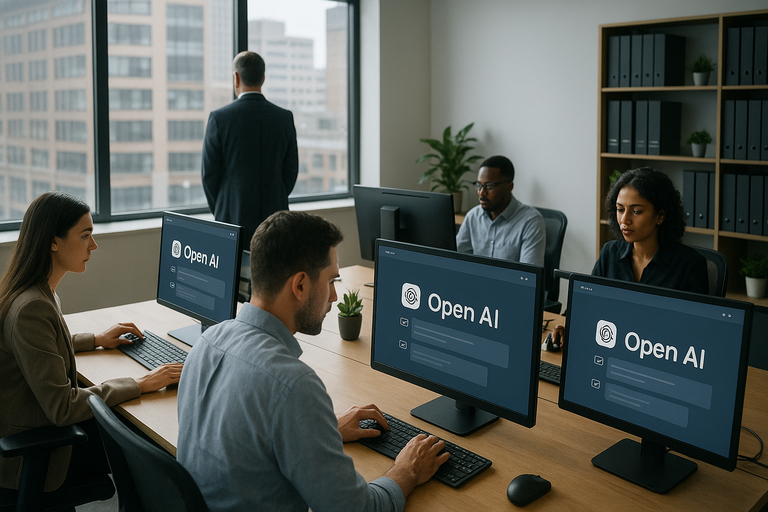Many employees are using AI tools without approval. Here’s what that means for your business.
They didn’t ask for permission. They just started doing it.
According to Salesforce, 28% of employees are already using generative AI at work, and more than half of those do so without their employer’s approval. Another Salesforce snapshot reveals that 61% use or plan to use generative AI, yet nearly 60% don’t know how to use it securely with trusted data sources. The same research shows 68% say AI helps serve customers better, while 73% agree it introduces new security risks.
This is a governance breakdown in plain sight.
Most small business owners think AI usage is something to plan for later. But that’s not how your team sees it. They use these tools to hit deadlines, serve customers faster, and write reports in minutes instead of hours. And they do it in ways that completely sidestep your security protocols.
They’re not malicious; they’re just trying to survive. You didn’t give them a safe way to use AI at work, so they found one on their own. Now, your sensitive data might be sitting in an unsecured model trained on public prompts.
You won’t see the damage until it’s too late.
The truth is, you’re already running an AI-powered business; you just don’t control it.
The question isn’t whether employees are using AI, it’s whether you’re paying attention. If you’re not, your team is relying on public tools; not enterprise-grade platforms. No audit trail. No compliance. No guarantee your data remains private.
Here’s what’s happening within your company, why it matters, and how to regain control without halting innovation.
Why Employees Are Turning to Shadow AI
They’re not trying to cause harm. They’re just trying to keep up.
Pressure builds, and team members will find shortcuts to get the job done. Increasingly, that shortcut is generative AI.
With 28% of employees using generative AI on their own terms, it’s desperation and ambition. Without approved tools, leadership, or training, shadow AI fills in.
Employees default to tools like ChatGPT, Claude, and browser extensions; using personal emails or private devices to avoid detection. That exposes internal strategy, customer info, and proprietary data to platforms your business doesn’t control.
This is leadership failure.
Only 10% of employees report receiving formal AI guidance. Leadership’s silence is interpreted as implicit permission.
To solve this, don’t ban AI. Create official paths.
The Security Leak You Didn’t Know You Had
It's not a data breach. It's something worse. It's invisible.
Your systems may look airtight, but that doesn’t matter when employees paste data into public AI tools.
According to Cyberhaven, the volume of corporate data input into AI tools surged 485% between March 2023 and March 2024. In one report, 74% of ChatGPT use at work happens via non-corporate accounts, exposing documents, code, HR data, and more.
Once data reaches public LLMs, it’s out of your control. Free tools may retain and train on that data. And standard cybersecurity tools can’t detect it, because AI use behaves like normal browser activity.
A future threat may look eerily familiar, with no way to trace its origin.
If your business handles sensitive information, this needs to be your wake-up call.
What Executives Are Getting Wrong About AI Governance
You don’t need an AI policy, you need an AI mindset.
Treating AI like another rollout is a mistake. Pick a vendor, train staff, launch, and done.
AI governance shapes how your organization approaches risk and innovation. It’s a leadership responsibility, not an IT fix.
Without clear goals (faster output, better service, lower cost) there’s no basis to know what to promote or prohibit.
Leadership must define ethical usage, model behaviors, educate teams, and provide approved processes. If you don’t set the tone, your people will follow uncertain paths.
How to Create a Safe AI Policy Without Slowing Your Team
Your people want to use AI. Give them a way to do it right.
Policies often swing between two extremes: ban everything or ban nothing. Neither works.
The best teams use AI with structure and clarity.
Cyberhaven’s research shows organizations adopting a culture of informed AI use, not fear, are winning.
Your policy should include:
Approved tools and platforms
Clear use case examples
Data safety rules (what stays out of AI)
Training for current and new staff
Visibility into AI usage for feedback and improvement
Guidance doesn’t slow down your team, it accelerates impact. When teams know what’s allowed, they stop guessing. Performance improves, and data stays safe.
You don’t have a tech problem. You have a visibility problem.
Right now, someone on your team is using AI to write a proposal, analyze data, or respond to customers; without your approval or protection.
Shadow AI emerges when leadership stays quiet. Your people want AI. It’s your role to channel it, not control it.
You don’t need edges or bans. You need clarity, approved tools, and real examples.
Ready to take control of AI in your business?
The INGRAIN AI™ Mastermind was built for business leaders who are ready to go from confusion to clarity. Join a small cohort of decision-makers building responsible AI strategies that align with real business outcomes.
Learn how to spot shadow AI before it becomes a threat
Get plug-and-play policies and frameworks you can roll out immediately
Work alongside experts and peers solving the same high-stakes problems

